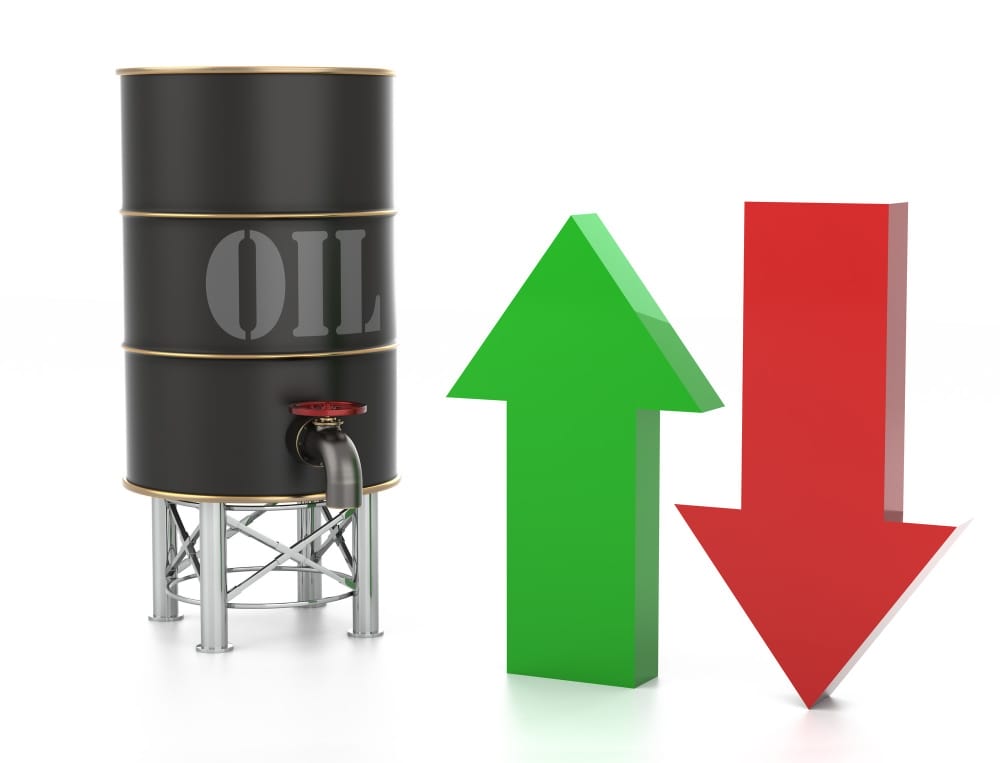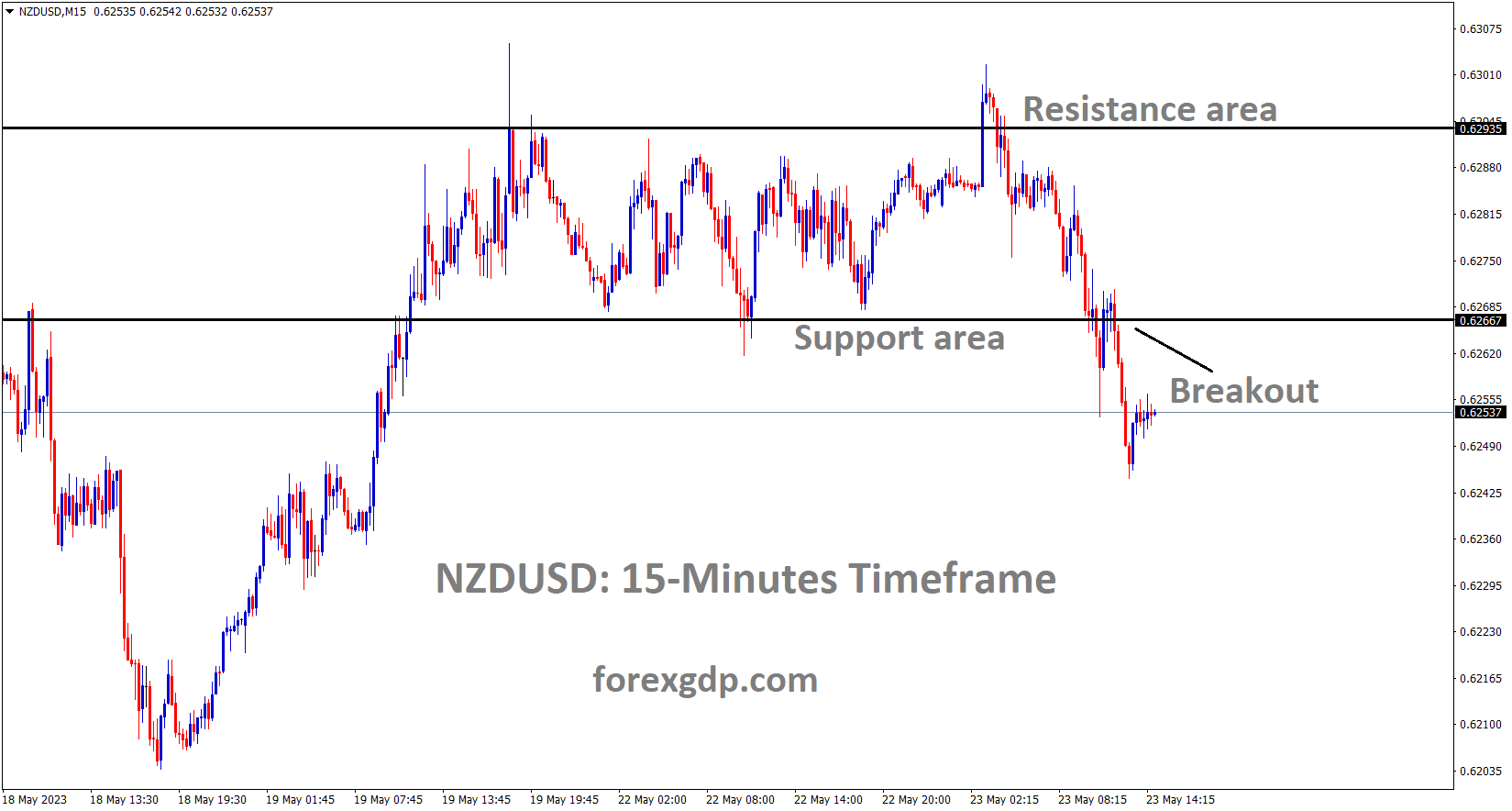Crudeoil: WTI Stops Slump as Saudi Raises June Oil Prices
The Oil prices extended gains after the Saudi Arabia rises Oil prices in the June month for Asia, Europe and Mediterranean countries. Israel rejected the Hamas request of release of hostages in equal manner and close the War to end. This news renewed fears on the Supply Side of Oil. US FED eased the treasury savings to $25 Billion from $60 Billion this shows more spending in the economy and US Dollar weakness in the market. This is also support for Oil prices to Gain.
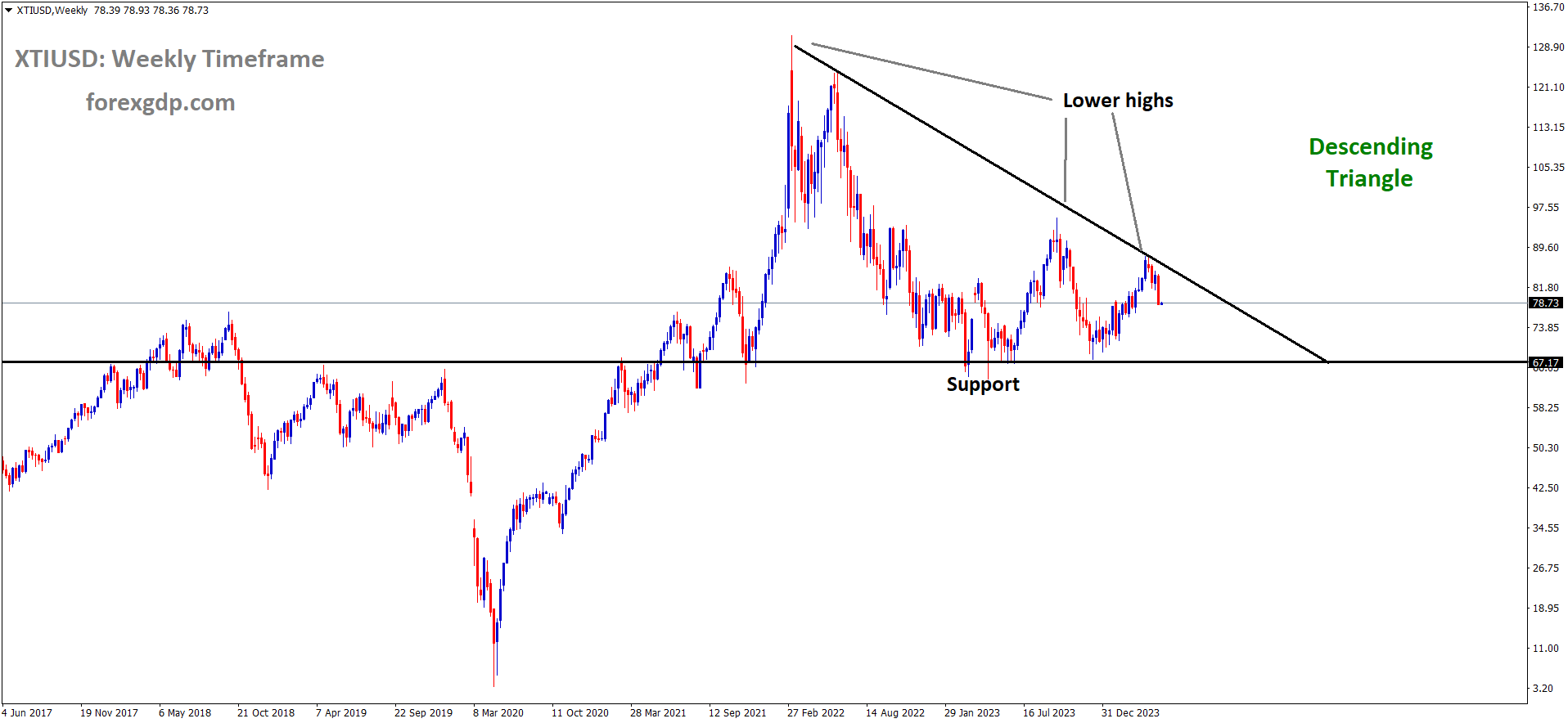
XTIUSD is moving in Descending Triangle and market has fallen from the lower high area of the pattern
WTI Crude Oil Breaks Losing Streak as Saudi Arabia Hikes June Prices
In the Asian session on Monday, the West Texas Intermediate (WTI) crude oil price bounced back, hovering around $78.20 per barrel. This uptick came after Saudi Arabia announced increased June crude prices for most regions. The hike in Official Selling Prices (OSPs) for crude sold to Asia, Northwest Europe, and the Mediterranean suggests expectations of robust demand in the upcoming summer season.
Additionally, the Organization of the Petroleum Exporting Countries and its allies (OPEC+) are likely to maintain current oil production levels for another three months. This decision is expected when ministers reassess output allocations on June 1. Last week, OPEC+ producers expressed readiness to extend voluntary output cuts of 2.2 million barrels per day (bpd) if oil demand doesn’t recover as anticipated.

Geopolitically, concerns over a potential failure of a Gaza ceasefire deal have pushed oil prices higher. The ongoing Israel-Hamas conflict in the Middle East raises fears of escalated tensions, with Hamas linking a ceasefire to the release of hostages, a demand rejected by Israeli Prime Minister Benjamin Netanyahu.

On the demand side, lower-than-expected US job data has renewed hopes for Federal Reserve interest rate cuts, which could stimulate economic activity in the US. This, in turn, may boost oil demand. Additionally, the prospect of lower interest rates is pressuring the US Dollar (USD), making crude oil more affordable for countries using alternative currencies.
Crude oil: Oil Jumps Over 3% as Fed’s Powell Soothes Rate Hike Worries
Oil prices continued their upward trajectory following Saudi Arabia’s decision to raise oil prices for June in regions including Asia, Europe, and the Mediterranean. Concurrently, the ongoing conflict between Israel and Hamas, marked by Israel’s rejection of Hamas’ demand for the release of hostages, reignited concerns about oil supply dynamics. This geopolitical tension contributed to market anxieties on the supply side, supporting oil price gains.
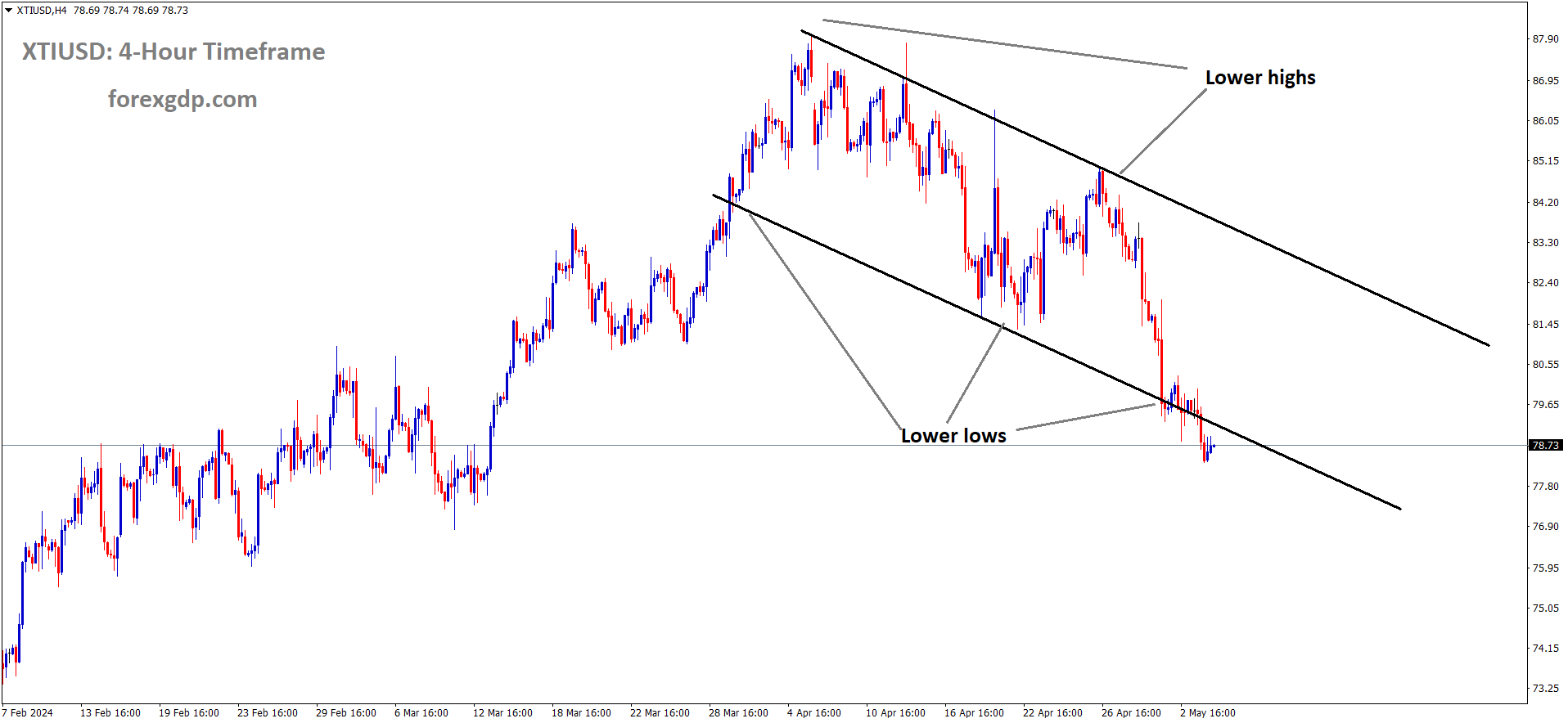
XTIUSD is moving in Descending channel and market has reached lower low area of the channel
Meanwhile, the U.S. Federal Reserve (FED) adjusted its Treasury savings from $60 billion to $25 billion, indicating a shift towards increased spending in the economy. This move is interpreted as a signal of potential weakness in the U.S. dollar in the market. The weakened dollar typically correlates with higher oil prices, as it makes crude oil more affordable for buyers using alternative currencies. Hence, the FED’s policy adjustment further supported the upward momentum in oil prices.
Oil prices surged more than 3% on Tuesday following remarks from the head of the U.S. central bank that alleviated market concerns about imminent interest rate hikes. Concurrently, an uptick in demand from China also contributed to the price rally.
Brent crude futures witnessed a $2.70 increase, equivalent to 3.3%, reaching $83.69 per barrel. Meanwhile, U.S. West Texas Intermediate crude futures saw a rise of $3.03, representing a 4.1% climb to $77.14 per barrel.
U.S. Federal Reserve Chair Jerome Powell’s comments on Tuesday addressed the robust jobs data released the previous week, emphasizing that it merely underscored the ongoing need for a gradual approach to raising rates. Powell refrained from speculating on whether prior knowledge of the data’s strength would have impacted the Fed’s decision on the recent 25-basis-point rate increase. He emphasized that the January jobs report highlights the prolonged nature of the monetary policy tightening process.
Following the release of the data, the U.S. dollar index experienced a decline, thereby bolstering oil prices. Typically, interest rate hikes strengthen the dollar, potentially making crude oil more expensive for non-U.S. buyers.

Anticipated heightened demand in China further buoyed crude prices on Tuesday. The International Energy Agency projected that half of this year’s global oil demand growth would stem from China, with notable increases in jet fuel demand.
Saudi Arabia, the leading oil exporter globally, raised prices for its flagship crude for Asian buyers for the first time in six months, citing expectations of demand recovery, particularly from China.
The suspension of operations at a 1-million-barrel-per-day (bpd) oil export terminal in Ceyhan, Turkey, following a significant earthquake in the region, also influenced market dynamics. The BTC terminal, responsible for exporting Azeri crude oil to international markets, is set to remain closed through Wednesday.
In the United States, the U.S. Energy Information Administration (EIA) forecasted an increase in U.S. crude production for 2023, while demand is expected to remain flat, according to its Short Term Energy Outlook (STEO) released on Tuesday.
Crude Oil: Oil Rises Further Amid Middle East Tension Escalation
The rise in oil prices, prompted by Saudi Arabia’s decision to increase prices for June in regions including Asia, Europe, and Mediterranean countries, coincided with Israel’s rejection of Hamas’ hostage release request, intensifying concerns about oil supply. Additionally, the U.S. Federal Reserve’s adjustment of treasury savings from $60 billion to $25 billion signaled increased spending in the economy and a weaker U.S. dollar, further supporting oil price gains.
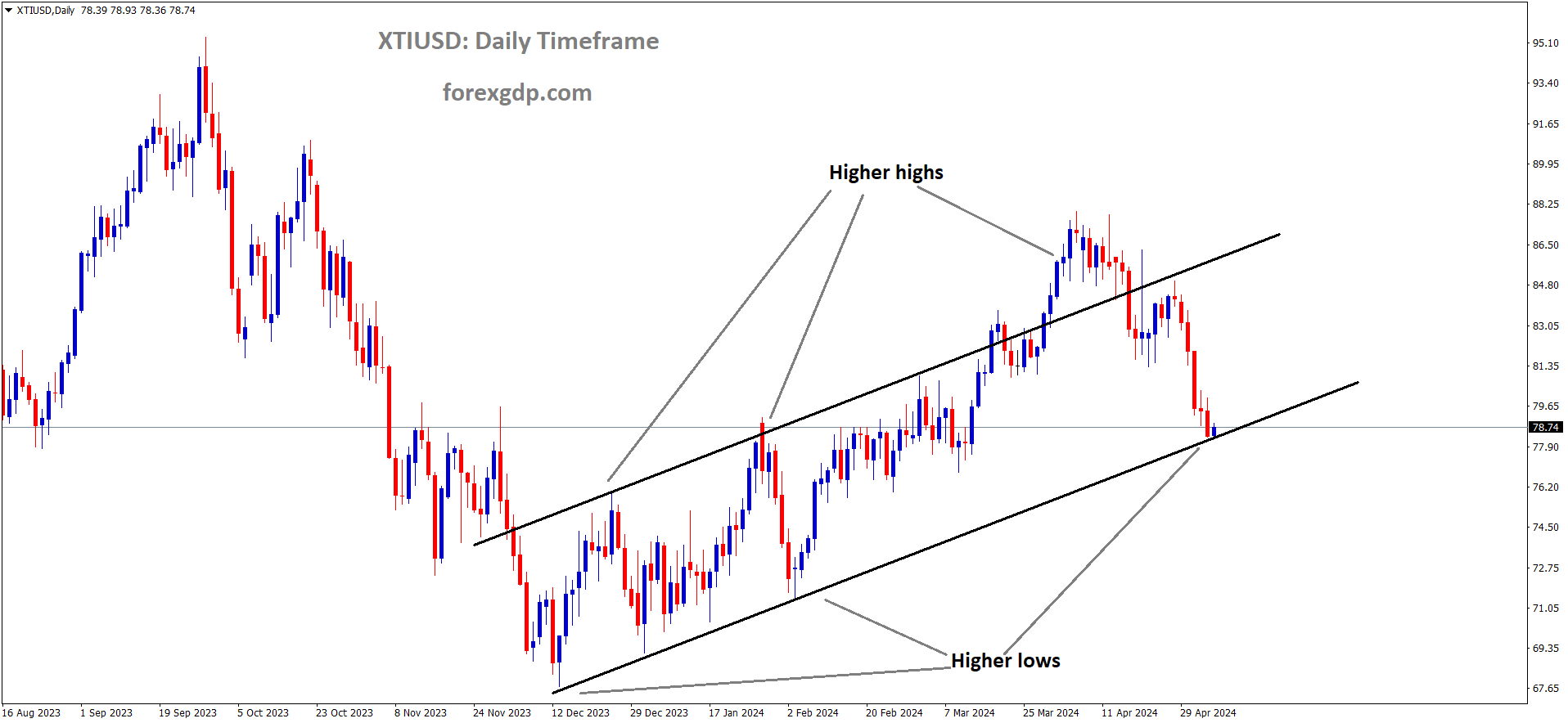
XTIUSD is moving in Ascending channel and market has reached higher low area of the channel
Oil prices continued their upward trajectory on Thursday, following a notable increase of a dollar per barrel in the previous session. This surge comes as investors brace themselves for a potential escalation of the Middle East crisis, with Iran, the third-largest oil producer in OPEC, being a significant focal point of concern.
The surge in oil prices follows a previous session where both contracts experienced a more than 1% increase. This uptick was attributed to an Israeli airstrike in Gaza that resulted in the deaths of three sons of a Hamas leader. The incident raised apprehensions about the potential stalling of ceasefire talks between Israel and Hamas, which had commenced earlier in the week but failed to yield any agreement.
Market strategist Yeap Jun Rong from IG remarked, “Prices remain sensitive to geopolitical developments in the Middle East, with market participants pricing for the risks of supply disruptions if tensions were to drag for longer.” Yeap also noted the market’s adjustment of rate expectations, suggesting that higher interest rates could dampen economic growth and suppress oil demand.
Furthermore, concerns about inflation and the prospect of an extended period of tight monetary policy in the United States have influenced market sentiment. Investors, who initially anticipated a rate cut in June, now view September as a more probable timing for the easing cycle to commence, especially following several stronger-than-forecast readings on consumer inflation.

The ongoing geopolitical uncertainties in the Middle East, particularly the possibility of Iranian retaliation following a suspected Israeli airstrike on Iran’s embassy in Syria earlier in the month, have added to the market’s apprehension. Reports indicating the anticipation of major missile or drone strikes by Iran or its proxies against Israel have further fueled concerns.
US Secretary of State Antony Blinken’s assurance of standing with Israel against any threats by Iran has underscored the gravity of the situation. Analysts, such as Daniel Hynes from ANZ, have expressed growing concerns that the Israel-Hamas conflict could escalate across the Middle East, potentially putting oil supply at risk.
Oil traders are closely monitoring the situation, with anticipation for the monthly oil market reports from both the Organization of the Petroleum Exporting Countries (OPEC) and the International Energy Agency (IEA), scheduled for release later in the week.
Don’t trade all the time, trade forex only at the confirmed trade setups
Get more confirmed trade signals at premium or supreme – Click here to get more signals , 2200%, 800% growth in Real Live USD trading account of our users – click here to see , or If you want to get FREE Trial signals, You can Join FREE Signals Now!

